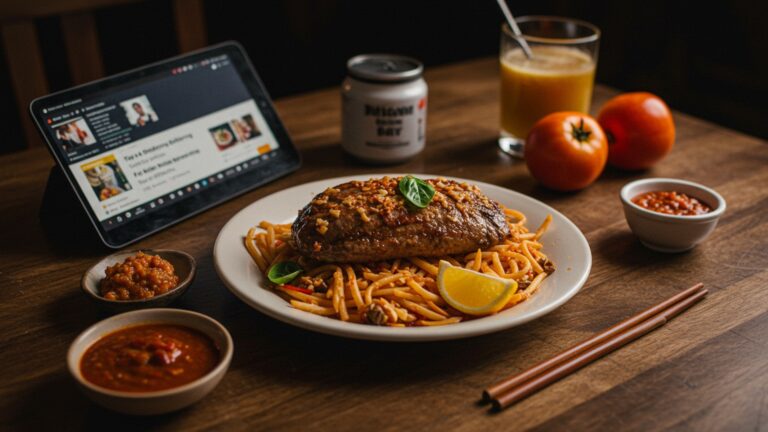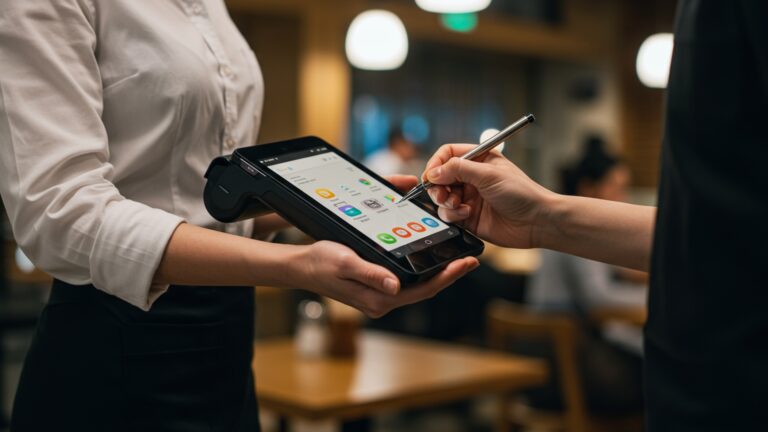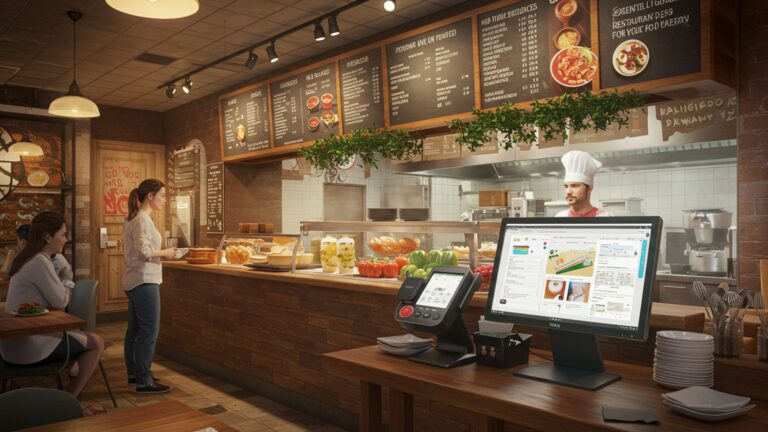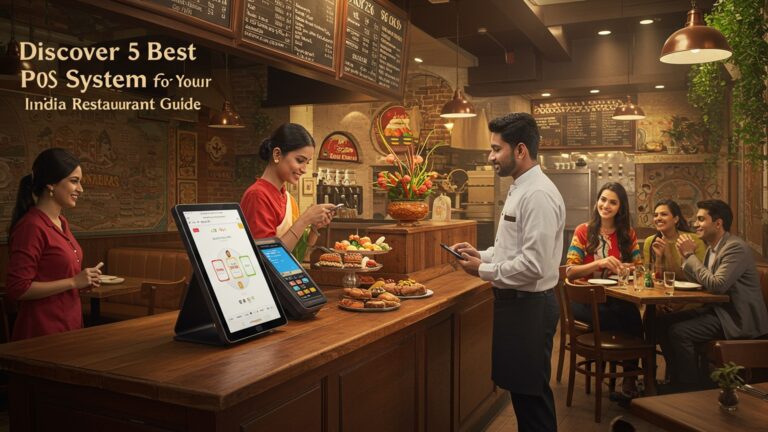How to Choose the 5 Best POS System Options for Your India Restaurant
The burgeoning Indian F&B sector, marked by rapid digitisation and evolving consumer expectations, necessitates a robust Point-of-Sale (POS) system that goes beyond mere transaction processing. With the surge in online delivery platforms like Swiggy and Zomato, coupled with the ubiquity of UPI payments and the growing preference for QR code ordering, restaurant operators face complex integration challenges. Selecting the best POS system for restaurants India is critical, impacting everything from inventory management for multi-cuisine kitchens to real-time sales analytics and customer relationship management. A modern, cloud-native solution, offering seamless aggregator integration and resilient offline capabilities, is no longer a luxury but a fundamental requirement for operational efficiency and sustained profitability in today’s competitive landscape.

Understanding the Core: What is a Restaurant POS System?
At its heart, a Point of Sale (POS) system for a restaurant is far more than just a cash register. It’s an integrated hardware and software solution designed to streamline all aspects of a restaurant’s operations, from taking orders and processing payments to managing inventory and tracking sales. Think of it as the central nervous system of your establishment, connecting the front of house (FOH) with the back of house (BOH) and providing critical insights into your business.
Historically, POS systems were clunky, on-premise setups requiring significant investment and technical expertise. Today, the landscape has evolved dramatically, with sophisticated, user-friendly. often cloud-based systems making advanced restaurant management accessible to businesses of all sizes. The modern POS system comprises several key components:
- Hardware: This typically includes a touch-screen monitor, cash drawer, receipt printer. often a barcode scanner or kitchen display system (KDS). Mobile POS (mPOS) solutions might use tablets or smartphones.
- Software: The brain of the operation, this application manages transactions, tracks inventory, generates reports. integrates with other systems.
- Payment Processing: Integration with various payment gateways to handle credit/debit cards, UPI, mobile wallets. cash transactions securely.
- Networking: For cloud-based systems, a stable internet connection is paramount. On-premise systems rely on local network infrastructure.
The Indispensable Role of a Modern POS in Indian Restaurants
In India’s vibrant and competitive food and beverage (F&B) industry, a modern POS system isn’t just a luxury; it’s a strategic imperative. From bustling street-side eateries to high-end fine dining, restaurants face unique challenges that a robust POS can effectively address. The search for the Best POS system for restaurants India often begins with understanding these specific pain points:
- Operational Efficiency: Manual order taking, billing. inventory tracking are prone to errors and slow down service, especially during peak hours. A POS automates these processes, leading to faster table turns and reduced wait times.
- Inventory Control: Food waste and pilferage can significantly impact profitability. A good POS tracks ingredients, alerts you to low stock. helps manage recipes to minimise waste.
- Payment Versatility: India’s payment ecosystem is diverse, with a strong preference for UPI, mobile wallets. cash alongside traditional cards. A POS that seamlessly integrates all these options is crucial for customer convenience.
- Staff Management: High staff turnover is common in the F&B sector. An intuitive POS reduces training time for new employees and helps manage shifts, payroll. performance.
- Delivery Integration: The rise of food delivery aggregators (Swiggy, Zomato, etc.) means restaurants need a system that can consolidate orders from multiple platforms, preventing missed orders and streamlining kitchen operations.
- Customer Experience: Faster service, accurate orders. loyalty programs powered by a POS contribute directly to higher customer satisfaction and repeat business.
As industry expert Chef Ranveer Brar often emphasizes, “In the restaurant business, precision and efficiency are as vital as the quality of your food. A smart system underpinning your operations can make all the difference.” This highlights why finding the Best POS system for restaurants India is a critical decision for any restaurateur looking to thrive.
Key Features Defining the Best POS System for Restaurants India
When evaluating options for the Best POS system for restaurants India, certain features stand out as non-negotiable for success in the local market. These are the functionalities that drive efficiency, enhance customer experience. provide actionable insights:
- Order Management & KOT (Kitchen Order Ticket) System:
- Digital Order Taking: Allows servers to take orders on tablets or handheld devices, sending them directly to the kitchen or bar.
- Table Management: Visual representation of table layouts, indicating occupied, vacant, or reserved tables, helping manage seating efficiently.
- KOT Generation: Automated generation of KOTs for kitchen staff, ensuring accuracy and reducing miscommunication. Separate KOTs for different kitchen sections (e. g. , mains, desserts, bar).
- Order Customization: Easy modifications for special requests (e. g. , “no onion,” “extra spicy”).
- Inventory Management:
- Recipe Management: Tracks ingredient consumption based on recipes sold, providing real-time stock levels.
- Stock Alerts: Notifies management when specific ingredients are running low, prompting timely reordering.
- Vendor Management: Helps manage supplier details and purchase orders.
- Waste Tracking: Records spoiled or wasted items to provide a clearer picture of actual costs.
- Billing & Payments:
- Multi-Payment Options: Supports cash, credit/debit cards, UPI, mobile wallets (Paytm, Google Pay, PhonePe). even QR code payments – essential for the Indian market.
- Split Billing: Allows customers to split bills by item or by amount, a common request in group dining.
- GST Compliance: Automatically calculates and applies Goods and Services Tax (GST) as per Indian regulations, generating compliant invoices.
- Discounts & Offers: Easy application of promotional discounts, loyalty points, or happy hour pricing.
- Customer Relationship Management (CRM) & Loyalty Programs:
- Customer Database: Stores customer contact details, order history. preferences.
- Loyalty Programs: Facilitates creation and management of loyalty points, gift cards. membership programs to encourage repeat visits.
- Feedback Management: Integrates with feedback systems to capture customer opinions directly.
- Reporting & Analytics:
- Sales Reports: Detailed breakdown of sales by item, category, server, time of day. payment method.
- Cost Analysis: Helps grasp food costs, labour costs. operational expenses.
- Performance Metrics: Insights into popular dishes, peak hours. staff performance, enabling data-driven decisions.
- Remote Access: Allows owners to monitor sales and operations from anywhere, a significant advantage for multi-outlet businesses.
- Third-Party Integrations:
- Delivery Aggregators: Seamless integration with platforms like Swiggy, Zomato. Dunzo to consolidate online orders.
- Accounting Software: Connects with Tally, Zoho Books, or QuickBooks for simplified financial management.
- HR/Payroll Systems: For larger operations, integration with HR tools can streamline staff management.
- Mobile/Tablet Capability:
- Handheld Ordering: Empowers servers to take orders tableside, improving speed and accuracy.
- Manager Access: Allows managers to oversee operations and access reports on the go.
Cloud-Based vs. On-Premise: Architectural Choices for Your Restaurant
The fundamental choice between a cloud-based and an on-premise POS system significantly impacts your restaurant’s operations, costs. scalability. Understanding their differences is crucial for finding the Best POS system for restaurants India.
| Feature | Cloud-Based POS | On-Premise POS |
|---|---|---|
| Data Storage | Data stored remotely on vendor’s servers (cloud). Accessible from any internet-enabled device. | Data stored locally on your restaurant’s servers/computers. |
| Cost Structure | Typically subscription-based (SaaS model), lower upfront cost. Monthly/annual fees. | Higher upfront cost for software license and hardware. Lower recurring fees. |
| Accessibility | Access from anywhere with an internet connection (e. g. , monitor sales from home). | Primarily accessible within the restaurant network. Remote access often requires complex setup. |
| Maintenance & Updates | Vendor handles all maintenance, updates. security patches automatically. | Restaurant is responsible for maintenance, updates. security. May require IT staff or external support. |
| Scalability | Highly scalable. Easy to add more terminals, locations, or features as your business grows. | Scalability can be complex and expensive, often requiring new hardware or software licenses. |
| Internet Dependency | Requires a stable internet connection for full functionality. Some offer offline modes. | Less reliant on internet. may need it for external integrations or payment processing. |
| Security | Vendor responsible for robust data security and backups, often with industry-standard encryption. | Restaurant responsible for data security, backups. disaster recovery. |
| Initial Setup | Quicker and simpler setup, often just requiring software installation on existing devices. | More complex installation of hardware and software, potentially requiring professional IT services. |
For the Indian Context: Cloud-based systems are increasingly popular due to their lower initial investment, ease of management. ability to operate even with fluctuating internet connectivity (many offer robust offline modes that sync once connectivity is restored). This flexibility makes them a strong contender for the Best POS system for restaurants India, especially for multi-outlet chains or smaller businesses with limited IT resources. On-premise solutions might appeal to larger, established restaurants with in-house IT support and a preference for full control over their data and infrastructure.
Identifying Your ‘Best’ Fit: Five Categories of POS System Options for Indian Restaurants
Choosing the Best POS system for restaurants India isn’t about finding a single “best” product. rather identifying the system that best aligns with your specific operational needs, budget. growth aspirations. Here, we outline five categories of POS system options, each tailored to different restaurant archetypes and priorities.
Option 1: The Budget-Friendly & Mobile-First POS (Ideal for Cafes, Food Trucks, Small Takeaways)
For budding entrepreneurs or small-scale operations, a system that minimises upfront costs and offers maximum flexibility is paramount. These POS options typically run on affordable tablets or smartphones, making them highly portable and easy to set up.
- Key Characteristics: Low monthly subscription fees, minimal hardware investment, intuitive user interface, basic inventory tracking, integrated payment processing (especially UPI).
- Use Case: A small coffee shop needing quick order taking and billing, a food truck managing a limited menu on the go, or a takeaway joint prioritising speed of service. For example, a chai cafe in Bengaluru that primarily handles cash and UPI payments and needs to quickly process customer orders without extensive menu customisation would find this option ideal.
- Why it’s a “Best Option”: It offers essential functionalities without overwhelming a small business with complex features or high costs, enabling them to professionalise operations quickly.
Option 2: The All-in-One Comprehensive POS (Ideal for Fine Dining, Multi-Cuisine Restaurants, QSR Chains)
These robust systems are designed for restaurants with complex menus, multiple service areas. a need for deep operational control. They integrate nearly every aspect of restaurant management into a single platform.
- Key Characteristics: Advanced table management, detailed inventory and recipe management, robust KDS, comprehensive reporting, CRM, staff management. extensive third-party integrations (delivery, accounting).
- Use Case: A fine-dining restaurant in Mumbai requiring precise ingredient tracking for gourmet dishes, detailed customer profiles for personalised service. seamless integration with delivery platforms. Or a Quick Service Restaurant (QSR) chain needing consistent operations across multiple outlets and centralised reporting.
- Why it’s a “Best Option”: It provides unparalleled control and visibility across all operations, allowing for sophisticated management and strategic decision-making in larger, more intricate setups.
Option 3: The Integration-Focused POS (Ideal for Restaurants Heavily Reliant on Online Delivery)
With the surge in online food delivery, many Indian restaurants find a significant portion of their revenue comes from platforms like Swiggy and Zomato. This category of POS excels at streamlining these external orders.
- Key Characteristics: Deep, real-time integration with major food delivery aggregators, automatic order acceptance, centralised order dashboard for all online and offline orders, menu synchronisation across platforms.
- Use Case: A cloud kitchen in Delhi handling hundreds of orders daily from multiple aggregators, needing to avoid manual order entry and potential errors. Or a popular restaurant that wants to manage dine-in and delivery orders from a single screen efficiently.
- Why it’s a “Best Option”: It solves the critical pain point of managing disparate online orders, reducing operational chaos. improving order accuracy and delivery times, directly impacting profitability.
Option 4: The Analytics & CRM Powerhouse POS (Ideal for Restaurants Focused on Customer Loyalty & Data-Driven Growth)
For establishments that prioritise understanding their customers, building loyalty. making data-informed business decisions, this POS option offers advanced analytical capabilities and robust CRM features.
- Key Characteristics: Sophisticated sales analytics, customer segmentation, built-in loyalty program management (points, rewards, gift cards), detailed customer history tracking, feedback collection tools, predictive analytics for menu planning.
- Use Case: A popular cafe in Pune aiming to build a strong base of repeat customers through personalised offers and targeted marketing. Or a multi-outlet restaurant group looking to identify best-selling items, peak hours. customer demographics to optimise marketing campaigns and menu offerings.
- Why it’s a “Best Option”: It empowers restaurateurs with deep insights into their business and customers, allowing them to foster loyalty, personalise experiences. drive growth through intelligent strategies.
Option 5: The Scalable & Enterprise-Ready POS (Ideal for Franchises, Large Chains. Rapid Expansion)
When operating multiple branches or planning significant expansion, a POS system that can grow with you, offering centralised control and consistent operations across all locations, is essential.
- Key Characteristics: Centralised menu management for all outlets, consolidated reporting across multiple branches, multi-location inventory management, user-role based access control, robust security. dedicated enterprise-level support.
- Use Case: A national chain of South Indian restaurants opening new outlets across different cities, needing to maintain consistent pricing, menu items. operational standards. Or a franchise model where the franchisor needs oversight of all franchisee operations.
- Why it’s a “Best Option”: It provides the infrastructure and tools necessary to manage complex, multi-location operations efficiently, ensuring brand consistency and facilitating scalable growth.
Evaluating Potential POS Systems: Beyond Features
While features are critical, the best POS system for restaurants in India also hinges on several other factors that impact long-term satisfaction and operational success. Don’t overlook these crucial evaluation criteria:
- Vendor Reputation & Support:
- Local Presence: Does the vendor have a strong presence and support team in India? Localised support can be invaluable for faster issue resolution.
- Customer Reviews: Check online reviews and testimonials from other Indian restaurateurs. Platforms like G2, Capterra. even local business forums can offer insights.
- Support Channels: What kind of support is offered (24/7, phone, chat, email)? Is it in local languages? Timely and effective support is non-negotiable for critical systems like POS.
- Training: Does the vendor offer comprehensive training for your staff, both initially and for new hires?
- Pricing Models:
- Transparency: Are all costs clearly laid out, or are there hidden fees (setup, training, integration, support)?
- Subscription vs. One-time: comprehend if it’s a monthly/annual subscription (SaaS) or a one-time purchase with recurring maintenance fees. Cloud-based systems are typically subscription-based.
- Hardware Costs: Factor in the cost of necessary hardware (terminals, printers, KDS screens).
- Ease of Use & Training:
- Intuitive Interface: The system should be easy for your staff (servers, kitchen, managers) to learn and use, regardless of their tech proficiency.
- Minimal Training Time: A complex system can lead to errors and frustration, especially with staff turnover. Look for systems that can be mastered quickly.
- Security & Data Privacy:
- Data Encryption: Ensure customer and business data is encrypted both in transit and at rest.
- PCI Compliance: If processing card payments, the system must be Payment Card Industry Data Security Standard (PCI DSS) compliant.
- Backup & Recovery: For cloud systems, interpret their backup protocols. For on-premise, you’ll need your own robust backup strategy.
The Seamless Implementation Journey: Your Path to POS Success
Once you’ve identified potential candidates for the Best POS system for restaurants India, the implementation phase is critical. A smooth transition ensures minimal disruption to your operations and maximises your return on investment.
- Trial Periods & Demos: Most reputable vendors offer free trials or detailed demos. Use this opportunity to test the system with your actual menu, payment methods. staff to see how it performs in a real-world scenario. Don’t just watch a demo; get hands-on.
- Data Migration: If you’re switching from an older system, inquire about data migration services. Can your existing menu items, customer database. inventory counts be imported smoothly?
- Staff Training: Schedule dedicated training sessions for all your staff, including FOH, BOH. management. Hands-on practice is key. Ensure there’s a designated point person on your team who becomes a system expert.
- Phased Rollout: For larger restaurants, consider a phased rollout. Start with one section or during off-peak hours to iron out any kinks before a full launch.
- Post-Implementation Support: interpret the level of support available immediately after going live. Who do you call if something goes wrong on day one? A vendor that provides excellent post-implementation support can be the difference between success and frustration.
For instance, a restaurant owner in Goa who recently upgraded their POS shared their experience: “The initial week was a bit challenging. the vendor’s local support team was constantly in touch, guiding us through every query. Their quick response to a payment gateway issue during a busy weekend saved us from major losses. This level of support is what truly makes a POS system the ‘best’ for a restaurant in India.”
Actionable Steps to Select the Best POS System for Your India Restaurant
Choosing the Best POS system for restaurants India is a significant investment. Follow these actionable steps to make an informed decision:
- Assess Your Needs:
- What type of restaurant do you operate (cafe, fine dining, QSR, food truck)?
- What are your busiest times and average transaction volumes?
- What are your biggest operational challenges (inventory, order accuracy, delivery management)?
- What’s your budget for upfront costs and monthly subscriptions?
- Prioritise Features: Based on your needs, list the must-have features (e. g. , KOT, UPI integration, inventory) and the nice-to-have features (e. g. , advanced CRM, predictive analytics).
- Cloud vs. On-Premise: Decide which architectural model best suits your internet reliability, IT infrastructure. control preferences.
- Research Vendors: Identify 3-5 top POS system providers known in the Indian market. Look for those with good reviews and a strong local presence.
- Request Demos & Trials: Get hands-on with the systems. Test them thoroughly with your staff and real-world scenarios. Pay attention to ease of use.
- Scrutinise Pricing: Obtain detailed quotes, including all hardware, software, installation, training. ongoing support costs. Compare total cost of ownership over 1-3 years.
- Check Support & References: Inquire about their customer support structure in India. Ask for references from similar restaurants in your region.
- Evaluate Integration Capabilities: Ensure the system integrates seamlessly with your existing or planned third-party tools (delivery apps, accounting software).
- Plan for Implementation: Discuss the onboarding process, training. post-launch support with the vendor.
- Make Your Decision: Choose the system that best balances features, cost, support. ease of use for your unique restaurant environment.
Conclusion
Choosing the ideal POS system for your Indian restaurant is a strategic investment, not merely a purchase. It’s about empowering your operations, from managing the unique rush of a Diwali dinner to effortlessly tracking inventory for authentic regional dishes like Hyderabadi Biryani. My personal advice? Beyond the feature list, always prioritize a live demo or a free trial. Observe how a system handles common Indian restaurant scenarios – can it easily split bills for a large family gathering, manage multiple KOTs across a busy tandoor and curry section, or process UPI payments seamlessly, a non-negotiable in today’s digital India? The right system integrates effortlessly with the current trends, supporting everything from QR code ordering to robust delivery platform integrations, which are crucial for success in metropolitan hubs. Remember, a well-chosen POS, one that aligns with your restaurant’s specific rhythm and customer base, is your silent partner in growth. It’s the backbone that allows you to focus less on administrative tasks and more on crafting those memorable culinary experiences. Make this informed decision, understanding the essential features for POS software success. watch your restaurant flourish, becoming more efficient and profitable than ever.
More Articles
How to Pick the Best Restaurant POS System for Small Restaurants India
7 Smart Benefits of a Restaurant POS System for Small Restaurants India
10 Factors to Select the Best POS System for Your Indian Restaurant
7 Best Affordable Restaurant POS Systems India Businesses Must Explore
Top 5 POS Software Solutions for Cloud Kitchens India Needs Today
FAQs
Why is a good POS system so crucial for my Indian restaurant?
A robust POS system is the backbone of any successful restaurant, especially in India. It helps you manage orders, track inventory, process payments quickly. grasp sales trends. This leads to faster service, less waste. ultimately, happier customers and better profits.
What are the absolute must-have features I should look for in a POS for an Indian restaurant?
Definitely look for features like comprehensive order management (dine-in, takeaway, delivery), detailed inventory tracking (including raw materials for curries and breads), multi-currency and split billing options, integration with online food delivery platforms, real-time sales reporting. robust CRM for customer loyalty programs. Also, ensure it handles India-specific GST and other taxes correctly.
How do I make sure the POS system can handle India’s unique billing and tax requirements?
This is super crucial. When evaluating options, explicitly ask if the system is GST-compliant and can generate proper invoices. Check if it supports different tax rates for various items and services. Many local Indian POS providers are built with these regulations in mind, so they might be a good starting point.
Cloud-based vs. on-premise POS – which one makes more sense for my restaurant in India?
Cloud-based systems are generally more flexible and popular now. They store data online, meaning you can access reports from anywhere, updates are automatic. upfront costs are often lower (subscription model). On-premise systems store data locally, offering more control but requiring you to manage hardware and updates. For most Indian restaurants, the flexibility and lower maintenance of a cloud-based system are usually more beneficial.
What about pricing? What should I expect to pay. are there hidden costs?
Pricing varies widely. Cloud systems usually have monthly or annual subscription fees, which can range from a few thousand rupees to much more, depending on features and number of terminals. On-premise systems might have a higher upfront cost for software and hardware. Always ask for a complete breakdown of costs, including setup fees, training, hardware, ongoing support. any extra modules you might need. Don’t forget transaction processing fees if the POS includes payment gateway integration.
How crucial is local support and training from the POS vendor?
Extremely crucial! You’ll want a vendor with responsive customer support that understands your local operational nuances and can provide quick assistance if issues arise. Good training for your staff is also vital to ensure smooth adoption and efficient use of the system. Look for vendors with a strong presence or dedicated support teams in India.
Once I’ve shortlisted a few, what’s the best way to actually compare different POS options?
After shortlisting, ask for live demos of each system. Test them out with your actual menu items and scenarios. Talk to other restaurant owners who use these systems for their feedback. Pay close attention to ease of use, scalability (can it grow with your restaurant?) , reporting capabilities. how well it integrates with other tools you might use, like accounting software or loyalty apps. Don’t rush the decision!






